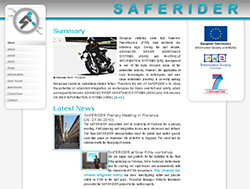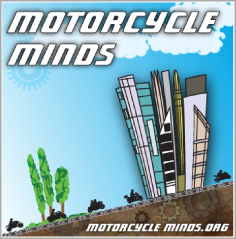 Motorcycle News (MCN) has branded the high-tech on-board warning system developed through the EU SAFERIDER project by MIRA, as “utterly useless”, “deeply flawed”, “distracting” and “potentially dangerous”.
Motorcycle News (MCN) has branded the high-tech on-board warning system developed through the EU SAFERIDER project by MIRA, as “utterly useless”, “deeply flawed”, “distracting” and “potentially dangerous”.
At Right To Ride we ran our “No To Throttle Control” campaign which focused on the SAFERIDER project and specifically regarding a force feedback throttle which would be able to tune the return force of the throttle through a servo controlled electric motor in order to communicate a speed reduction warning. The result of our campaign was that the Consortium admitted they had got it wrong and withdrew the “force feedback throttle from their project.
Throttle Control was only part of a raft of technologies that were investigated and developed through SAFERIDER. The other was a “curve warning” system which is intended to alert riders if they are approaching a bend to fast using satellite positioning technology and sensors on the motorcycle.
The “curve warning” system can transmit to the rider in various ways, including a pulsating throttle (handle bar), vibrating cheek pads in the helmet, vibrating gloves, vibrating seat, audible warning in the helmet and visual warning on a display unit.
Kevin Ash MCN columnist says the “safety bike” (Triumph Sprint ST) developed by MIRA is an ill-judged waste of time and cash” and asks the question, “How the hell did this get the go-ahead?” His main issue with the system is, “…how on earth a pre-programmed assessment of a bend, taken from a map, can come up with a speed which is in any way representative of how fast a bike really can get around that corner safely” and what about liability if a rider crashes in a bend when the system is in use and alludes to the different skills or riders.
Right To Ride’s, Trevor Baird said, ”Having ridden previously a MIRA developed motorcycle fitted with audible, visual, vibrating warnings and throttle control, these systems take away the normal sensory control that a rider should have and is taught, without interference and reliance on extra invasive sensory warnings such as these developed in the SAFERIDER project.”
 However MCN tester Derek Crutchlow aged 65 years said, “If you’ve been brought up in a motorcycle environment you wouldn’t like it. You’ll want to think for yourself. But maybe if I was a new rider I would adapt to it. And anything that could make biking seem safer, improve its image and appeal to new riders, I’m all for.” But would it appeal to young or novice riders? Or is it more likely that they are looking for wheels to get around and take them away from the humdrum of everyday life – such as the pleasure and fun of riding a bike?
However MCN tester Derek Crutchlow aged 65 years said, “If you’ve been brought up in a motorcycle environment you wouldn’t like it. You’ll want to think for yourself. But maybe if I was a new rider I would adapt to it. And anything that could make biking seem safer, improve its image and appeal to new riders, I’m all for.” But would it appeal to young or novice riders? Or is it more likely that they are looking for wheels to get around and take them away from the humdrum of everyday life – such as the pleasure and fun of riding a bike?
Perhaps in Derek Crutchlow’s statement we see the death knell for the future of motorcycling as we know it now. Is unwelcome technology creeping in? Will new and young riders accept this technology creep as part of motorcycling? Do we as motorcyclists, with certain opinions about this technology need to defend more rigorously its adaption for motorcycling? In fact do we have a problem?
Whether these systems become attractive or not is not the point. Kevin Ash is right – they are dangerous, simply because they anticipate conditions and events that even in perfect circumstances such as the MIRA test track, are uncertain.
This has not stopped the Federation Of European Motorcyclists Association (FEMA) headed by its General Secretary treading a dangerous path in hand with the EU Commission, by praising the outcome of the project and calling for SAFERIDER II to continue developing these safety systems.


I am a 27 year old rider. I passed my test in January 2011 and I believe that the new tech that people are talking about is going to detract from the riding experience.
I know that if the new tech is introduced I will be sticking to older bikes that do not have it so as to have the freedom to make mistakes and learn from them.
While I agree that biking has inherent dangers I feel that every one who goes for the licence to ride is aware of them and decides to take the tests and the risks on.